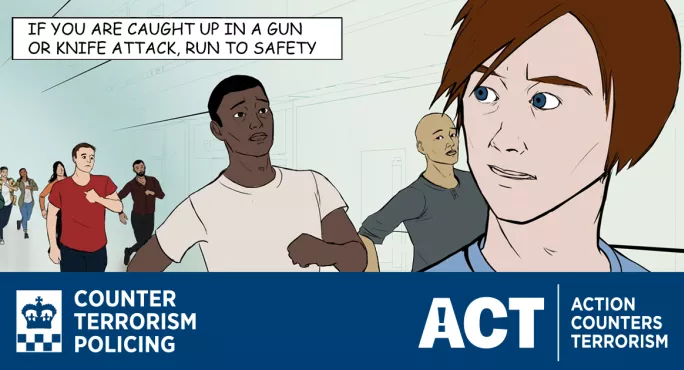- Home
- Police produce first-ever lesson plans on how to survive a terror attack
Police produce first-ever lesson plans on how to survive a terror attack

Advice for pupils on how to survive terrorist gun and knife attacks is to be made available to schools across the country for the first time.
The lesson plans for key stage 3 and 4 pupils have been produced by the National Counter Terrorism Security Office (NaCTSO) and the PSHE Association, and are backed by the Department for Education.
The materials are an extension of the government’s Run, Hide, Tell campaign and address the threat of terrorist attacks in crowded places.
They are based around a six-minute film called Run, Hide, Tell - The Story Of Nur, Edih and Llet. The film follows the story of three young people reflecting on how they managed to survive an attack on a shopping centre.
The film deliberately avoids any images of an actual attack and does not have the sounds of people screaming, although shouts and gunfire can be heard. The perpetrators of the attack are never seen or discussed directly.
The resources urge pupils to run to safety, hide and tell police, should they become involved in a gun or knife attack.
Children are told not to “waste time” taking pictures or videos of the scene, and to report anything they see that looks suspicious.
A separate lesson plan has been devised by St John Ambulance. Called TREAT, it aims to teach pupils life-saving first-aid techniques to use if they need to help someone who has been stabbed or shot.
“These lessons will go way beyond the basic messaging we have delivered through previous public-facing campaigns,” said Metropolitan Police deputy assistant commissioner Lucy D’Orsi.
The teaching materials are available to download via the National Police Chiefs’ Council website.
‘An attack on the school site’
The lesson plan states: “The focus of this lesson material is on promoting personal safety procedures for young people when they are out and about independently.”
It adds: “Although the lesson and film makes no reference to an attack on a school premises, it is likely that one of the first questions students ask will be focused on what might happen if such an attack were to take place on the school site.
“We, therefore, recommend that schools ensure they have a shared safety plan for this eventuality before teaching the lesson, in much the same way that all schools have a fire drill procedure.”
Although the lessons are not compulsory, schools are being urged to use them to ensure that pupils are prepared in the “unlikely event” of a terror attack.
Deputy assistant commissioner D’Orsi said: “Whilst we cannot make these lessons mandatory in schools, I would strongly urge education providers and youth organisations to consider delivering this life-saving information to the 11-to-16-year-olds in their care”.
She added: “We appreciate this can be a difficult subject to speak to young people about, but we’ve carefully designed everything to be age-appropriate and we know from our research that this is information that young people want to be equipped with”.
‘Like a fire drill’
Detective Sergeant David Parkes, NaCTSO counter-terror awareness lead, told Tes that police want children to react to a terror attack in the same way they would to a fire alarm.
“Look at fires and fire drills and the way that they’re viewed by schools and by youth organisations, and they don’t panic, they don’t cause alarm,” he said.
“Fires are terrible and yet the guidance and the ability to save your own life is an everyday part of life. So we need to make that leap to get away from the emotive side of Run, Hide, Tell to a far more practical place where the guidance is delivered, is absorbed, way before anything bad happens”.
He described the attack at the Ariana Grande concert in Manchester earlier this year as “a tipping point, where so many youngsters were caught up in that”.
He added: “If you understand the threat and know what to do, our thinking is that the fear of terrorism goes down. Fires are terrible but fire alarms people take with a pinch of salt, and that’s where we want to be”.
Avoiding ‘shock horror’
The new materials have been deliberately designed to avoid any shocking impact that would detract from pupils’ learning, according to Jenny Barksfield, PSHE Association deputy chief executive.
She said: “Often, even teachers will say ‘kids like things to be really hard-hitting, it really engages them’, but actually that’s about enjoyment and excitement rather than about the learning”.
Ms Barksfield said: “ It’s not about making it a hard-hitting film. The message is hard-hitting enough without over-dramatising and we particularly also didn’t want to focus on the perpetrators. It could be anyone, for any reason…we didn’t want any shock horror tactics”.
A Department for Education spokesperson commented: “Schools have a legal responsibility to ensure staff and pupils are safe. We provide a range of support for schools, and constantly review guidance to ensure it is comprehensive and up to date. The National Counter-Terrorism Security Office also provides specialist advice on staying safe in the rare event of an attack, including tailored advice for education establishments.”
Want to keep up with the latest education news and opinion? Follow Tes on Twitter and Instagram, and like Tes on Facebook
Keep reading for just £1 per month
You've reached your limit of free articles this month. Subscribe for £1 per month for three months and get:
- Unlimited access to all Tes magazine content
- Exclusive subscriber-only stories
- Award-winning email newsletters



